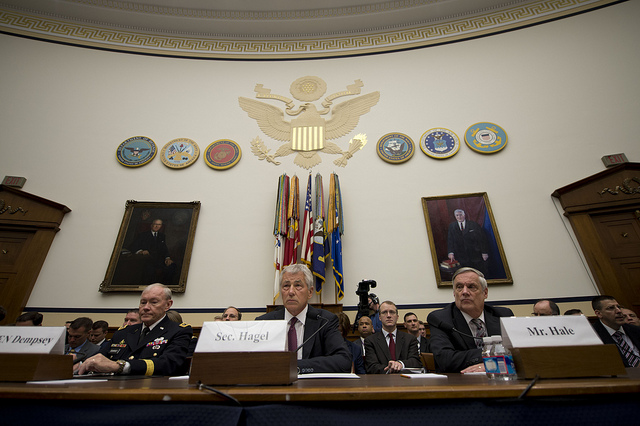Readers of the recently released US Quadrennial Defence Review will be struck by one major characteristic: namely, a fondness for the notion of ‘rebalancing’. Asian readers looking for signals of the Obama administration’s commitment to the rebalance to Asia will be delighted to see that the QDR delivers. But they might be less delighted to see that the document uses the term with relative abandon, indeed to the point where the word ‘rebalance’ starts to lose its meaning. In the space of the executive summary, for example, the document manages to talk about ‘rebalancing and sustaining our presence and posture abroad to better protect US national security interests’, ‘rebalancing for the 21st century’, ‘rebalancing for a broad spectrum of conflict’, ‘rebalancing our counter-terrorism efforts’, ‘rebalancing capability, capacity and readiness within the joint force’, and ‘rebalancing tooth and tail’ by reforming the US Department of Defense.
The overall effect is to create an impression that the US is attempting to walk several tightropes simultaneously. By the end of the executive summary, readers will be starting to wish the authors had been asked to redraft it without using the word ‘rebalance’ at all. I know the richness of the English language is such that if you see a new word it’s likely you’ll see it again within six days, but even by that metric, the authors’ affection for the term is hard to explain. Really, if so much rebalancing has to be done, doesn’t it imply that US global force posture is currently unbalanced, and so is its force structure, its Defense Department, its counter-terrorism efforts, and so on? And what does the word actually tell us, anyway? It’s like ‘impact’ used as a verb. Rebalancing implies a degree of acrobatic agility; a centredness that’s its own virtue. But what does it mean? The US says it’s rebalancing to Asia, but maintaining its commitments to Europe and the Middle East, and reaffirming that defence of its homeland remains its single highest strategic priority.
The QDR sits alongside a recent candid comment from Katrina Macfarland, US Assistant Secretary of Defence (Acquisition), that the rebalance to Asia ‘can’t happen’ because of budgetary pressures. It’s unwise to put too much emphasis on any one official’s comments, and she later clarified this remark insisting that the rebalance can and will continue, but the slip will only augment concerns across the region that the ‘rebalance’ has less meaning to it than US official statements would suggest. At one point in the QDR executive summary, the authors state that the US is exploring ‘new presence paradigms’, a phrase suggesting that the evolution away from major basing and towards a more rotational presence will continue. That’s not exactly a new approach: it dates back at least to the time (almost a decade ago) when Americans spoke about the increasing need for ‘lily pads’ rather than major facilities abroad. But it does suggest the Americans are looking to economise on how they adjust their strategic footprint in Asia.
I’ve previously argued that the US footprint is changing in response to a shifting strategic centre of gravity in Asia: that northeast Asia is no longer quite so dominant in its strategic weighting, and that the rise of China, India and Southeast Asia is pulling the centre of gravity south-westward. The effect is to pull US presence in the same direction, towards Southeast Asia and the Indian Ocean, so the rebalance isn’t only to Asia but within Asia. And that suggests the new presence paradigms will be unpacked in our sub-region. So this is a topic we might want to explore more closely with Washington. In essence, what will those new paradigms mean for US presence? The US marine deployment to the Top End, for example, isn’t a permanent presence, since there would be little point in having the marines there during the wet season. By contrast, the planned move of 4,000 US marines from Okinawa to Guam and another 2,000-3,000 to Hawaii does look a little more permanent, even if the moves remain the subject of funding battles in Congress.
For some Southeast Asian countries, wary of being tied too closely to the US, the new paradigms might well be politically more acceptable than a heavier footprint. Singapore, for example, is too small to host a heavier footprint. The Philippines has a chequered connection, and might find a lighter footprint more tolerable. The same can probably be said for both Indonesia and Vietnam. But it does leave unanswered the big question: what will the future US presence in Southeast Asia look like, and what role will Australia be willing to play to support it? In his concluding chapter to the QDR, US Chairman of the Joint Chiefs General Martin Dempsey, talks about differing forms of presence: permanent presence, prepositioned presence, rotational presence and surge capability. Perhaps, as the strategic future unfolds, we might be helping the US in all those areas.
Rod Lyon is a fellow at the Australian Strategic Policy Institute and an adjunct associate professor at the Griffith Asia Institute. Image courtesy of Flickr user Office of the Secretary of Defense.


